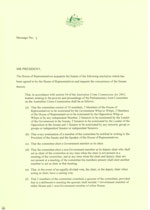General committee provisions
42 Joint committees
-
A proposal for a joint committee of the Senate and the House of Representatives agreed to by the Senate shall be forwarded to the House of Representatives by message.
-
The proceedings of a joint committee shall be reported to the Senate by one of the senators appointed to serve on the committee.
Amendment history
Adopted: 19 August 1903 as SOs 341 and 345 (corresponding to paragraphs (1) and (2)) but renumbered as SOs 337 and 341 for the first printed edition
1989 revision: Old SOs 351 and 355 combined into one, structured as two paragraphs and renumbered as SO 42; repositioned from old chapter XXVII on joint committees (and old chapter abolished); content streamlined and language simplified
Commentary

A message from the House of Representatives proposing the terms of reference for a joint committee
Formerly with a chapter of their own in the old standing orders, joint committees can now be provided for very simply in SO 42 because most matters relevant to joint committees are covered elsewhere. Some domestic committees are empowered to meet jointly with their House of Representatives counterparts (see SOs 20, 21 and 22 relating to the Library, House and Publications Committees). Joint standing committees are governed by their resolutions of appointment which cover their powers, membership and any other procedural matters considered necessary by the Houses at the time of establishment. Joint statutory committees are governed by their statutes, supplemented by resolutions as required, which are agreed to by both Houses. Standing order 40 covers meetings with House of Representative committees generally.
In their old form, these standing orders included references to joint committees having the same number of members from each House. For an account of the Senate’s response to the House appointing additional members to its Library and House Committees, and President Kingsmill’s outrage, see SOs 20 and 21. For commentary on joint committees causing potential difficulties for bicameralism, see Odgers’ Australian Senate Practice, 14th edition. Only half of the joint committees on which senators currently serve have equal numbers of members from each House and this stipulation has been removed from the standing orders. It has become principally a matter to be determined by the Houses when considering proposed resolutions of appointment of joint committees and legislation establishing joint statutory committees.
Whereas a Senate committee report is presented by its chair, a joint committee report may be presented by any of its Senate members. This is usually arranged in advance by the joint committee through its secretariat. Joint committee reports have been presented by both government and opposition committee members.